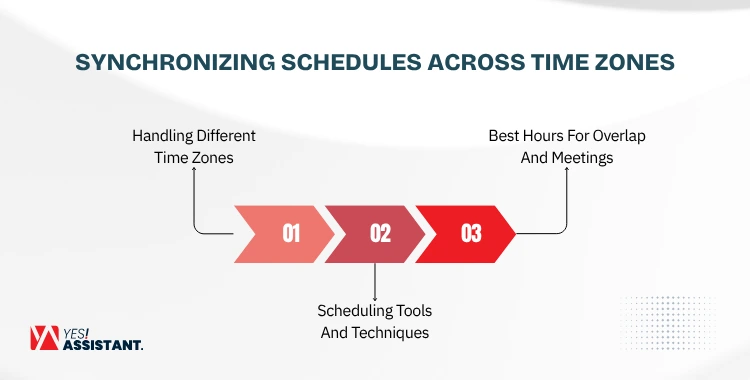
Best Practices for Working with a Remote Sales Assistant
A remote sales assistant position is a game-changing tool for your business. This position is especially for optimizing lead generation and supporting your sales team. Remote sales professionals specialize in working from a distance.
This support assistant mainly performs as a potential sales force, handling crucial administrative tasks, CRM management, lead generation, qualification, calendar, and email management. Remote sales assistants even perform in customer support and social media engagement
Comparing a general virtual assistant with a remote sales assistant contributes to a deep understanding of sales operations using the necessary tools. A remote sales assistant is an integral part of achieving your sales objective.
What's Inside
Understand the Role of a Remote Sales Assistant
High-quality lead generation is challenging for your business. To effectively optimize lead generation, a remote sales assistant is vital to support strategic methods to find the right customers. A remote sales VA tasks to find and engage with the right customers.
What is a Remote Sales Assistant?
A virtual sales support provider is a remote professional who supports your sales team, managing different tasks. They mainly handle admin tasks, including handling customer queries, scheduling appointments, and lead generation. These professionals do the same job as a regular sales rep, but provide their support from home or remote positions.
Additionally, a remote sales assistant performs sales operations with effective processes, updates CRM systems, and maintains strong relations with your clients. This sales VA role helps your sales professionals to focus on closing deals, improving efficiency, and customer engagement.
Typical Tasks and Responsibilities
A remote sales assistant’s scope of responsibilities can be easily configured on the basis of what’s required by a company’s sales department. Remote sales assistant tasks. The duties of a remote sales assistant are:
- Lead Generation and Qualification: Effectively research and evaluate lead information, including updating CRM systems with new contact data, identify and execute qualified calls and/or emails to book meetings.
- CRM Management: Ensuring that all CRM records are up to date. Logging interactions and keeping notes, refreshing deal stages, and generating reports.
- Calendar Management: Scheduled for essential meetings, provide demos, and follow up for sales reps.
- Email Management: Filtering essential emails by creating folders. Also, draft and send sales outreach emails, follow-up communications, and manage sales inboxes.
- Data Entry and Analysis: Updates sales data, tracks sales metrics, and helps the company’s top management analyze sales performance.
- Customer Support: Acting as a first point of contact for routine customer inquiries and delivering them to the appropriate department.
- Social Media Management: Engage customers with social media activities through crafting content, posts, or engage prospects with online chat.
- Proposal and Presentation Preparation: Assisting in creating, formatting, and proofreading sales proposals, presentations, and customer contacts.
Difference Between Virtual Assistants and Specialized Sales Support Roles
A remote sales assistant is a type of virtual assistant. A general virtual assistant (VA) offers work on multiple tasks of administrative and technical support services across various businesses. The key responsibilities of a sales enablement assistant are managing emails, scheduling appointments, handling social media, and performing basic accounting tasks.
A remote sales assistant specializes in sales support. The sales assistant has a deeper understanding of sales processes, terminology, and tools. Their skills are directly connected to achieving sales objectives; become a member of your sales team rather than a general member.
Define Clear Expectations from Day One
The foundation of a successful working relationship with a remote sales assistant is related to achieving a successful goal. Any contradiction can lead to frustration and underperformance.
Establishing job descriptions and deliverables
Before hiring, create a clear & concise job description. This clearly defines the specific responsibilities, required skills, and objectives of the role. Once hired, a remote sales VA, review your remote sales assistant, and expand the work based on the Job description. Define the distinct deliverables for each task.
For example, instead of “managing a CRM”, specify that all prospect interactions are logged in the CRM within 2 hours of occurrence, or “update deal stages daily for all action opportunities.” This precision is essential to expectation setting.
Setting KPIs and Performance Metrics
To measure success, provide constructive feedback, establish sales assistant KPIs, and performance metrics. These should be met-expectation setting goals. Which is directly related to the assistant’s responsibilities. Examples are as follows:
- Number of qualified leads generated per week/month.
- Accuracy of CRM data.
- Response time for sales inquiries.
- Number of appointments scheduled.
- Completion rate of administrative tasks.
- Adhere to the defined process.
Creating a Structured Onboarding
The remote onboarding for sales team members must be skilled. This isn’t just about setting up technically, it’s about becoming an integrated member of the team and knowing how sales work. The format of a well-designed onsite onboarding program is as follows:
- System Access and Training: The small SDR team will also receive access to all tools (CRM, communications, and sales enablement tools) with proper training on how to use them most efficiently.
- Process Deep Dive: Detailed documentation on your sales process, ideal customer, product/service details, and exact workflows.
- Team Introductions: Setting with formal and informal introductions to the sales team members they will be supporting.
- Resource Repository: Define a specific location for all relevant documents, templates, and guidelines.
- Initial Projects: Assigning manageable initial projects to help them apply their training and gain confidence.
Create Standard Operating Procedures (SOPs)
Companies have repetitive tasks; having a top management-approved Standard Operating Procedure (SOP) is a non-negotiable policy. They are especially critical when working with remote teams to ensure consistency and reduce dependency on constant supervision.

Documenting Repeatable Sales Processes
Identify all routine tasks that your remote sales assistant will perform and keep them documented step-by-step. This includes:
- How to qualify a lead.
- The process for updating a CRM record.
- Steps for scheduling a demo.
- Guidelines for preparing a sales proposal.
- Instructions for using specific software features.
These documentation steps served as a blueprint for efficient execution. This includes meticulous documentation of sales SOPs to ensure that tasks are performed correctly following procedures.
Ensuring Consistency And Clarity
SOPs are an independent policy & process of your company that resolves all contradictions. These procedures ensure that every task is performed within a similar process and in accordance with your company standards. Consistency is key to balancing the maintenance of data integrity, brand messaging, and comprehensive sales efficiency.
Clear documentation needs no further clarification and saves time for both you and your assistant. This is focusing on consistent workflow documentation, which leads to greater accuracy and fewer errors.
Easy Handoff For Future Scalability
One of the most overlooked benefits of well-documented SOPs is scalability. As per your documented policy regarding your remote assistant leave, working hours, miscellaneous activities, the transition and training of new hires are significantly smoother.
This facility’s process automation accelerates by making it easily repeatable by a human or virtual employee. It reduces the impact of personal changes and ensures business continuity.
Prioritize Time Zone and Schedule Alignment
Working with a remote team positions navigating different time zones. Proactive management always considers this aspect as crucial for effective collaboration.

Handling Different Time Zones
It’s a good decision to plan for time zone collaboration, considering remote virtual assistant’s location. If your assistant stays in another time zone, determine the best way to overlap working hours for real-time communication and meetings. It might involve adjusting your schedule, incorporating your core hours of availability.
It’s better to communicate about your expected working hours and ask your assistant for their priorities.
Scheduling Tools And Techniques
You can create a close connection between different time zones for meetings and collaboration by using scheduling tools. These automated tools convert time zones easily to find mutual conversion times for meetings. Project management software with a shared calendar can synchronize and help you to collaborate.
For instance, if you’re in Los Angeles, California, and your assistant is living in New York. Now understand that when it’s 12:00 PM in Los Angeles, it’s 3:00 PM in New York. This impacts when real-time collaboration can realistically occur.
Techniques include:
- Asynchronous Communication: Regarding no priority issues, communicate through emails, project management comments, or internal communication platforms, where your responses don’t need immediate action.
- Designated Overlap Hours: Identify a specific window period (like 2-3 hours) for every working day or week where both parties are expected to be available for live discussions.
These strategies contribute to creating an effective and collaborative time zone.
Best Hours For Overlap And Meetings
Determine the “Golden hours” when you and your remote sales assistant have chances to overlap. These are convenient to prioritize collaborative tasks, critical discussions, and check-in meetings.
A remote assistant can complete the task independently, which allows you to assist the flexibility to work during their most productive hours, regardless of your time zone.
This creates remote scheduling tips that foster efficiency. This approach also supports an async sales team model, allowing work to progress even when direct communication isn’t possible.
Chris Herd, CEO of Firstbase, a leader in remote work solutions, states, “Asynchronous work is about being intentional about communication, making sure information is accessible without requiring real-time interaction.” Medium by Liza Mash Levin titled “My hybrid work insights from a great interview with Chris Herd,” published on April 1, 2021.
Build a Collaborative Team Culture Remotely
Working with a remote team culture means connecting from a distance but deeply engaging with the team. Despite remote support, it’s a strong and collaborative culture for a remote sales assistant.
Creating Inclusion And Connection
Work collaboration creates a remote sales assistant as an integral part of the team. It includes VA in sales meetings, even if their direct communication is not always required. Encourage informal interactions through a dedicated chat channel for work discussions.
When remote sales assessments perform well, celebrate their success and acknowledge contributions officially. This is focusing on remote culture, which helps with mainstream operation through distance support.
Virtual Team-Building Practices
Facilitate virtual rapport building actively. This could involve:
- Virtual Coffee Breaks: Create short and informal video calls; therefore, team members can chat with the remote support team about unofficial topics.
- Online Games or Quizzes: Also, arrange occasional cultural activities like games or quizzes.
- Virtual Happy Hours: Arrange a social gathering online to connect cordially.
- Shared “Wins” Channels: Build a dedicated channel where team members can share their views and celebrate sales success insights, without considering the size of sales volume.
Recognition and Motivation
Develop a culture where you can recognize your remote professionals’ contributions and achievements. This could be verbal praise, cheers, or clapping in a team meeting, or a small virtual reward. Understand the remote support assistants’ motivation and customize recognition accordingly.
Providing opportunities for professional development and growth, and being highly motivating. Recognizing contributions is key to building virtual rapport and a positive working relationship.
Conclusion
Working with a remote sales assistant gives you immense potential outcomes to enhance your sales productivity and follow-up operations. Through understanding their roles, setting clear expectations from the outset, and documenting the process through SOPs, time differences.
You can set procedures that have the full value of partnership. Best practices will not only lead to more efficient sales but also contribute to building strong, productive, and beneficial relationships. Consequently, your remote sales assistant ultimately drives your sales team engagement towards greater success.




